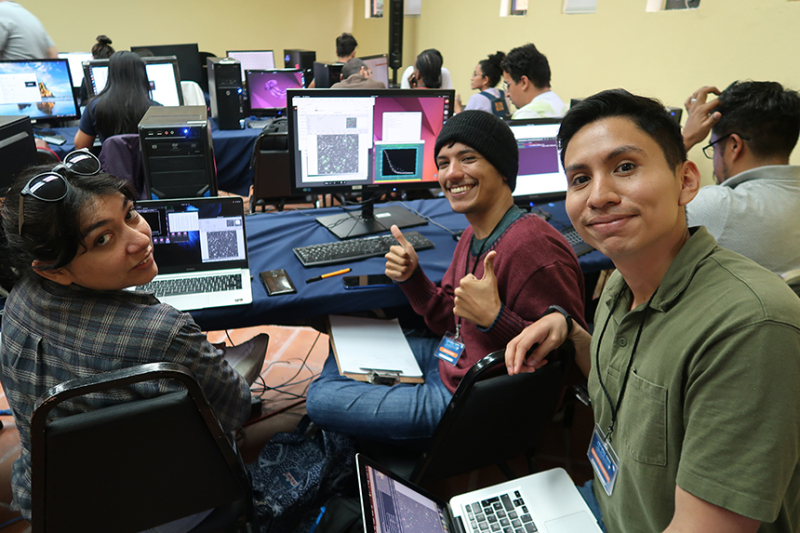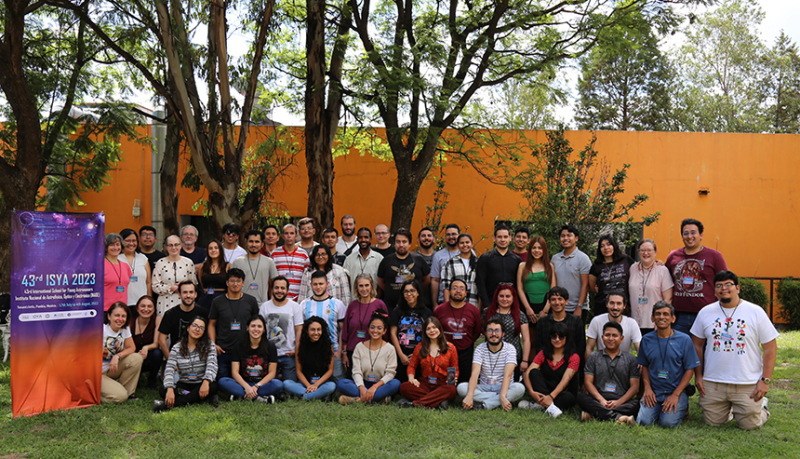The next great talent in astronomy could be from anywhere, including the global South. One recent addition to the Academy’s roster of TWAS Fellows has played a strong role in astronomical research, but is also preparing the next generation of astronomers—wherever they might live.
Itziar Aretxaga of Mexico, elected a TWAS Fellow in 2022 and inducted in 2023, has been a leader in major discoveries about young, distant galaxies. But as the leader of an international education programme for young astronomers, she has helped provide critical knowledge to students in countries where astronomy mentorship is difficult to find.
![TWAS Fellow Itziar Aretxaga. [Photo provided]](/sites/default/files/styles/cke_media_resize_large/public/media/aretxaga-working-web.jpg?itok=eCA_-PXm)
Seeking powerful star factories
Aretxaga was born and educated in Spain, but moved to Mexico 25 years ago, and is now a Mexican citizen. In her early life as an astronomer, she grew curious about how stars form around supermassive black holes that lie at the center of galaxies.
In time, her interests shifted to what she called the “fireworks” around these black holes: big bursts of star formation. These starbursts are most spectacular in very distant galaxies that are enshrouded with cosmic dust.
These galaxies are so far away that the light from them, by the time it reaches Earth, is roughly 13 billion years old. This means they are actually looking into the deep past, witnessing the earliest stages of the universe. And because the universe is expanding, those distant galaxies appear to be “moving away”.
The motion is similar to the drift of two spots on a balloon, moving apart as the balloon inflates. “Space is growing,” explained Aretxaga. “And that creates the perception that these galaxies are moving away from us. But actually, the universe is growing, and the galaxies are moving apart from us as the universe expands.”
Astronomers need special, powerful telescopes to observe these galaxies using “redshifted” light—because the galaxies are moving apart, the wavelength of the observable light stretches out, and thus appears “shifted” towards the red part of the light spectrum. The Large Millimeter Telescope Alfonso Serrano, where Aretxaga works, is located 4.6 kilometres above sea level atop Mexico’s extinct Sierra Negra volcano. It is the world’s largest telescope of its kind, designed to detect redshifted millimeter-wavelength waves and observe the early formation of distant stars, galaxies, planetary systems, and black holes. It is also a joint project between Mexico and the United States.
Aretxaga is an expert in research using redshifted light. Also among her findings are galaxies that form over a thousand solar masses—a solar mass is the equivalent of the sun’s mass—each year. By comparison, our own Milky Way forms only one solar mass each year. These highly efficient star factories show astronomers how many galaxies may have operated during the early history of the universe. Among her most prominent recent work in this area was a study led by her former PhD student, Jorge Zavala, published in Nature Astronomy in 2018. It described the most distant, luminous infrared star-forming galaxy yet recorded at the time.
![TolTec images from Itziar Aretxaga. [Photo provided]](/sites/default/files/styles/cke_media_resize_large/public/media/aretxaga-toltec-combo.jpg?itok=FDo6t2ox)
Now, Aretxaga and colleagues at several universities—the University of Massachusetts in Amherst, US; University of Northwestern, US; University of Michigan, US; Arizona State University, US; University of Cardiff, UK; and the National Institute of Astrophysics, Optics and Electronics in Mexico—are working on a new camera for the telescope. The camera is called TolTEC, and it is an enormous machine, spread over three stories, she said. It will enable them to create much larger and more detailed star maps of the distant past.
“The goal with this telescope and its maps is to understand how these galaxies are related to their environment, and to go much deeper to find new galaxies,” Aretxaga said. “We think we may find galaxies that correspond much more to our own when it was young.”
![TWAS Fellow Itziar Aretxaga. [Photo provided]](/sites/default/files/styles/cke_media_resize_large/public/media/aretxaga-standing-web.jpg?itok=3yoZCRng)
Intensive education for young astronomers
But Aretxaga’s contribution to science stretches beyond astronomical studies. She is the director of the International School for Young Astronomers (ISYA), a programme of the International Astronomical Union (IAU) designed to provide university students everywhere with training in modern astronomy techniques.
The programme takes place in a different parts of the world each year, and trains students in regions that lack a local research institute able to widely offer a specialised education in astronomy. Aretxaga described it as an intense three-week programme that entails constant work.
“These are very intensive schools,” she said. “The course is exhaustive. We interact with and teach them for three weeks, and do very little else. There are panels of lecturers. They have access to labs. They learn how to process data, access data, and understand machine learning. Then, they go back to their home countries.”
Most recently, from 17 July to 4 August, the school took place in Puebla, Mexico, and 39 students came from 14 Latin American countries. The next school will be in Cape Town, South Africa, from 19 November to 9 December. The school is being held twice this year to account for years missed due to the COVID-19 pandemic.

IAU created the school in 1967. Aretxaga first attended it as a lecturer in 2002. She later became its deputy director in 2016, and its director in 2018, a role she continues to this day. Since 2016, the school travelled to China, Colombia, Egypt, Mexico, and the Islamic Republic of Iran. In 2017, the school was in Ethiopia, a Least Developed Country (LDC).
“Ethiopia was tremendously important. It’s developing its space exploration agency, and in its universities students are pursuing astronomy PhDs,” she said. “And then Ethiopia, serving as the host country, could bring in other students from the region for the school—from Rwanda, Uganda, Nigeria, Ghana, Sudan, and Madagascar, among others.”
Aretxaga said that she regards Mexico, as a large country surrounded by many smaller countries, to be a “developing pole” when it comes to astronomy. Young astronomers from those smaller countries with fewer resources for astronomy could train in a country like Mexico with greater science capacity, and perhaps develop astronomical science capacity in their own countries after they return home.

“This program tries to open doors for students in those isolated environments to see what opportunities exist for them in astrophysics,” she said. “They make links, meet lecturers who are famous in the field, and perhaps receive a change in perspective about what they can do.”
“To our satisfaction, 70% of our students who have been able to follow up to become professional astronomers, they have returned to their country,” she added. “It’s not that different for them than it was for Spain and Mexico in the 1970s and 1980s, which now have a much stronger astronomical community than they did back then.”
Aretxaga said that becoming a TWAS fellow was a great honour for her and her work in both research and education.
“It means a lot that TWAS recognizes the value of what we’re doing and the impact these schools are having,” she said. “It was a really nice recognition. But I also see that it comes with responsibilities to the next generation of scientists—and there are many opportunities here to fulfil those responsibilities.”
Sean Treacy

